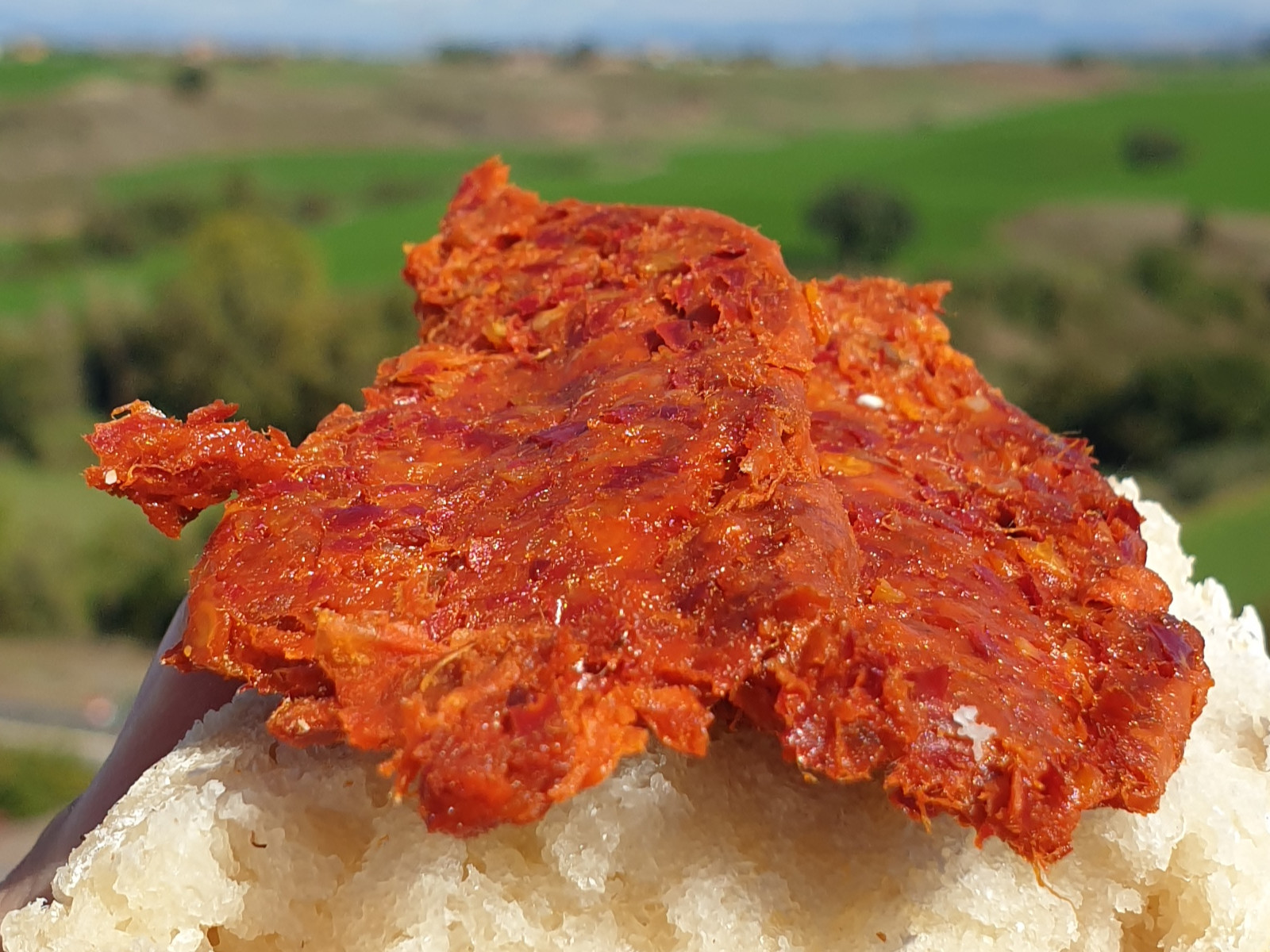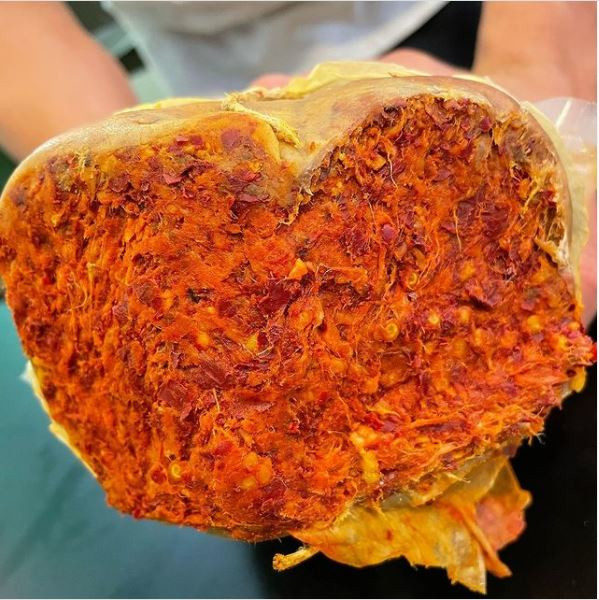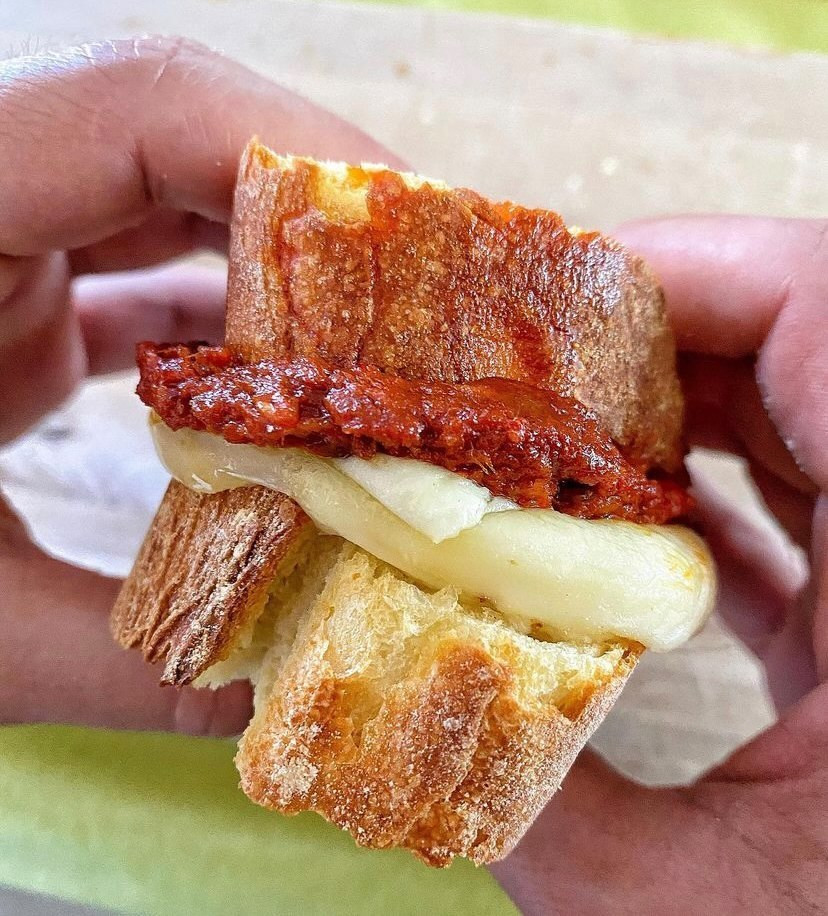Some say that the Calabria region is shy like its people. This may be why, notwithstanding an outstanding culinary tradition, where ingredients and recipes can boast the highest quality, a unique and long history and, above all,
extraordinary flavours.
An example? The enveloping, opulent
'nduja, one of the most gluttonous and famous
spreadable salami of Italy.
Tradition and productionRed like fire, extremely fragrant, buttery and soft even for the sight, '
nduja is a true delicacy for lovers of spicy food. It owes its inimitable character to a few, essential ingredients, basically pork meat, fat and chili, combined in a unique balance, with a process that has remained fundamentally unchanged for centuries and is still entirely artisanal.
Calabrian pork is usually of excellent quality, the result of small-scale farms. On top of that, important steps have been taken, in the last 20 years, to preserve it, especially protecting the breeding of the indigenous and precious
Black Calabrian pig. The habits of this animal, which lives in a semi-wild state between woods and mountain slopes, feeding on acorns, chestnuts, aromatic herbs, roots and vegetables, give its meat a unique flavour, praised already in the 1700s by the famous Venetian lover Giacomo Casanova. In addition, it also seems to have an interesting concentration of nutrients that are beneficial for our health.
‘
Nduja has been, for centuries, a dish for the working class, the so-called ‘poor cuisine', and for a long time it has been made with the wastes of pig slaughtering, and above all offal, lungs, heart, tripe and fats. Today, however, the opposite happens, and this delicious sausage is honored with the best cuts,
fatty but “noble” parts such as lard from the girth, bacon, bacon, shoulder meat and thigh.
The meat is minced several times until a homogeneous and creamy mixture is obtained. It is then flavored with hot pepper
dried in the wind and in the sun. Low-quality preparations use imported chilies, cayenne pepper or oriental spices, but the authentic 'nduja must strictly have the scent of native plants, originally from the Esaro Valley, like the chili of the Tri Pizzi variety, grown on Monte Poro, with their characteristic aroma. The bright red colour reminds us that, thanks to the antiseptic and antioxidant properties of chili, this delicacy does not require additives or preservatives.
When the mixture reaches the right creaminess and softness, it is stuffed into its container, the pig intestine. It is then smoked with aromatic herbs, such as the “black locust”, but also with smoke obtained from burning olive wood.
We then have to wait some 3 to 6 months of curing in a hygienically protected and temperature-controlled place, to be able to enjoy it: by then, the casing has turned brown, but the inside has retained all its surprising and intense red colour.
 From the French king to the Queen of Calabria!
From the French king to the Queen of Calabria!The exact origins of '
nduja are lost in time and are unknown. Some have suggested that it was born after the 1500s, when chili was brought to Italy by the Spaniards. However, its name suggests otherwise, because it is clearly related to the French word
andouille, and to Latin
inductilia, “things ready to be inserted”. The most accredited tradition wants it, in fact, heir of a French salami based on tripe and pork entrails brought to Italy during the Napoleonic domination (1806-1815) and distributed free of charge to the Lazzari, the young commoners from Campania who had taken up arms, to quell the revolt, by Gioacchino Murat,
Napoleon's brother-in-law and King of Naples.
It was an extraordinary success. The
Calabresi adopted the recipe, adapting it to local ingredients and taste, giving life to a magnificent, unique and fragrant product.
“Fari u porcu” … what does that mean? And where do you do it? '
Nduja actually has a precise place of birth and a very restricted area of production: the town of Spilinga, “city of '
nduja”, that has just over 1400 inhabitants, but also an extraordinary position that gives it sea and mountain breezes, two important ingredients in the production of the delicious sausage.
With the arrival of winter, here, as in many other Calabrian towns, we prepare for the centuries-old rite of the "quadara", which means slaughtering the pig and processing every single part of it, ensuring the supply of animal proteins for the whole year.
The 'nduja will be ready to be enjoyed at the beginning of spring, reaching the perfect degree of seasoning in the summer. Every year, since 1975, between the 6th and 8th of August, Spilinga celebrates the new production with a festival, which celebrates the expulsion of the Saracens together with the thousand variations of ‘nduja in local recipes. During the festival, we also perform the traditional dances, and giant statues in
papier-mâché are erected.
How to enjoy it at its bestFor many Calabrians, 'nduja is part of the identity, but also the base of delicious snacks with friends: what best than on slices of toasted bread? Perhaps with some ricotta to soften the spicy note when you are a little younger.
Dear to many for its supposed aphrodisiac properties, it has organoleptic characteristics that make it incredibly versatile, perfect for flavouring the most varied recipes.
Do not miss the
fileja with 'nduja:
fileja is a delicious homemade pasta, to be eaten with ‘nduja sauce and the sweet onions from Tropea. The recipe is anything but elaborate: just let the onions gently fry in olive oil, add a few pieces of soft 'nduja, then some ripe tomatoes and red wine, and let it go over the heat for the cooking time of the pasta. Yummy!
‘
Nduja can also be used as an accompaniment to semi-aged cheeses, as a topping for pizzas and bruschetta, as a special touch for omelets or for stuffed with meatballs and panzerotti. It is also perfect to flavour the sauté of a sauce with meat or tomato, or to give a spicy twist to vegetables.
Simple and delicious, like so many peasant foods, '
nduja is gradually conquering even the most refined palates. Once the protecting film that envelops it is removed, it is impossible not to fall into the spell of its unique colour, which lights up and conquers all the senses, releasing the most authentic scents and flavours of Calabria.


